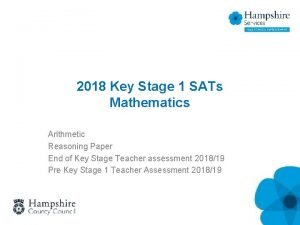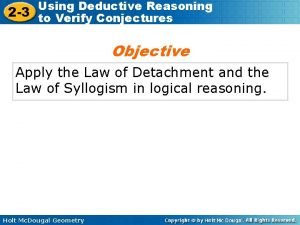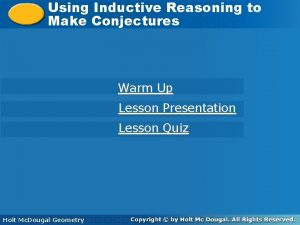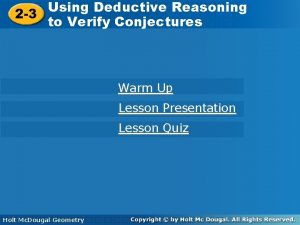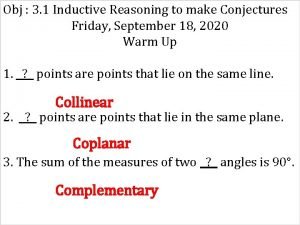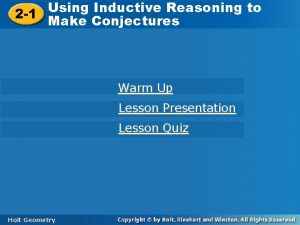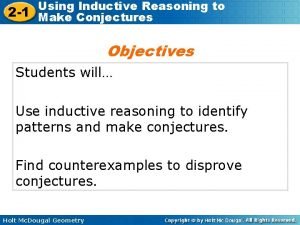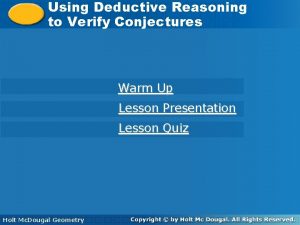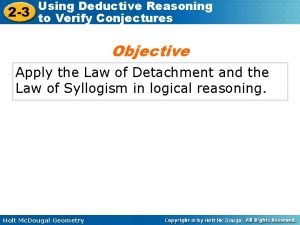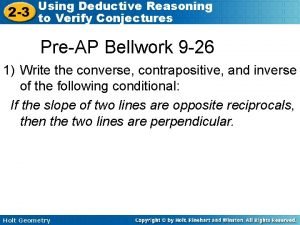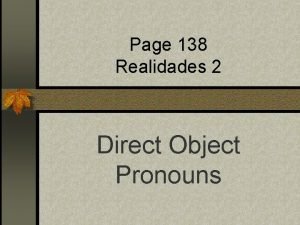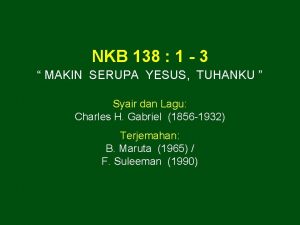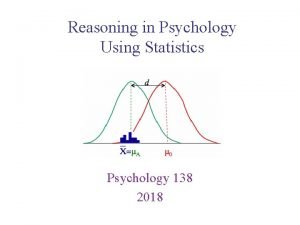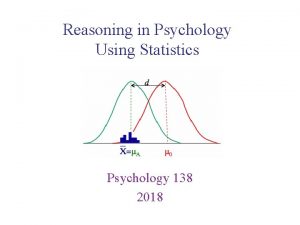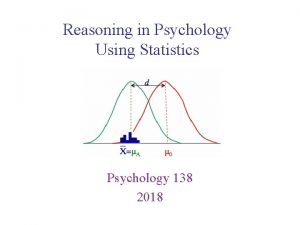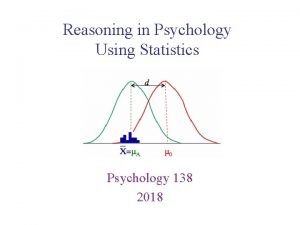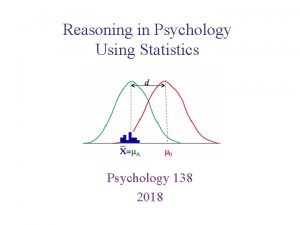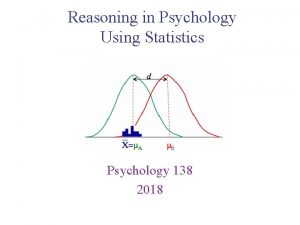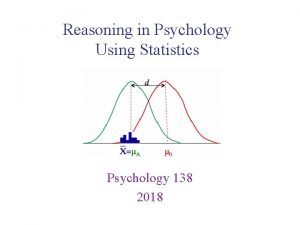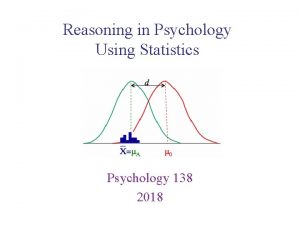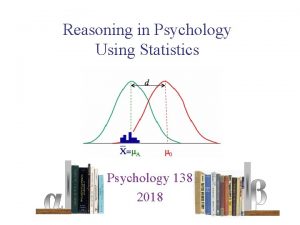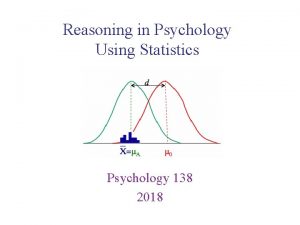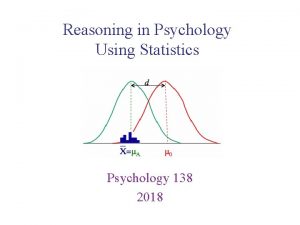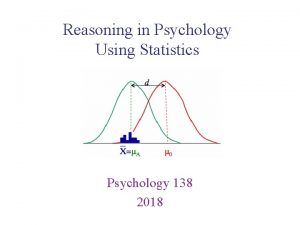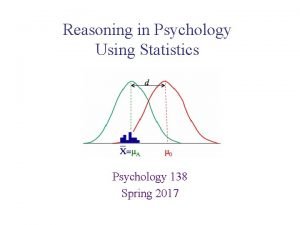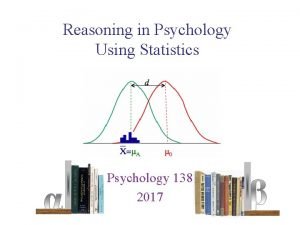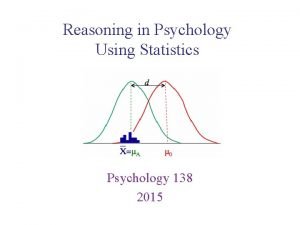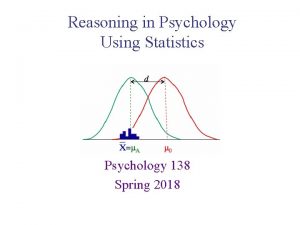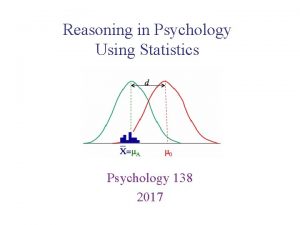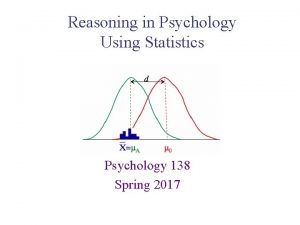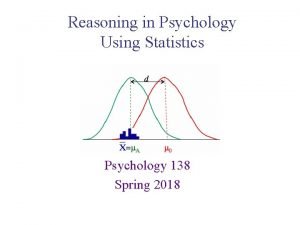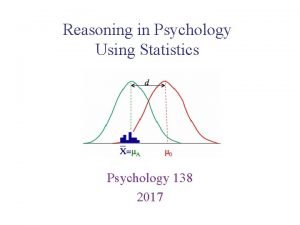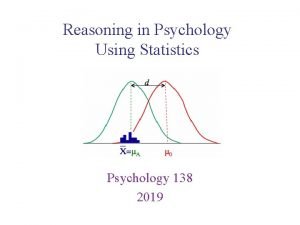Reasoning in Psychology Using Statistics Psychology 138 2018























- Slides: 23

Reasoning in Psychology Using Statistics Psychology 138 2018

• Quiz 10, due Friday May 4 th. You may take it up to 10 times, your top score is what counts. • Final Projects Due May 2 nd • Uploaded to Reggie. Net • Lab Exam 4 is Wednesday May 2 nd in lab sections • Final Exam: In here, Wednesday May 9 th 1 -3 PM Reasoning in Psychology Using Statistics

• Inferential Statistics: Procedures which allow us to make claims about the population based on sample data – Hypothesis testing – Testing claims about populations (based on data collected from samples) • Correlation • Regression • Chi-squared test – Estimation – Using sample statistics to estimate the population parameters • Point estimates • Confidence intervals – – 1 -sample z test 1 -sample t test Related samples t-test Independent samples t-test Lab Exam 4: Conclusions from Data Reasoning in Psychology Using Statistics

• Analyze the question/problem. – The design of the research: how many groups, how many scores person, is the population σ known, etc. – Write out what information is given – Is it asking you to test a difference, test a relationship, or make an estimate? – What is your critical value of your test statistic (z or t from table, you’ll need your α-level) • Now you are ready to do some computations – Write out all of the formulas that you will need – Then fill in the numbers as you know them • Interpret your final answer – Reject or fail to reject the null hypothesis? What does that mean? – State your confidence interval and what it means Performing your inferential statistics Reasoning in Psychology Using Statistics

• The design determines the test Which test do I use? Reasoning in Psychology Using Statistics

X Y A 6 6 B 1 2 C 5 6 D 3 4 E 3 2 Suppose that you notice that the more you study for an exam (X= hours of study), the better your exam score typically is (Y = exam score). Test if there is a significant correlation between the two variables (α = 0. 05) Correlation SSY = 16. 0 SSX = 15. 20 SP = 14. 0 Y 6 5 34 2 1 1 2 3 X 4 5 6 2 -tailed H 0 : ρ = 0 HA : ρ ≠ 0 df = n - 2 = 5 - 2 =3 rcrit = 0. 878 Reject H 0 There is a significant positive correlation between study time and exam performance Correlation within hypothesis testing Reasoning in Psychology Using Statistics

• The design determines the test Which test do I use? Reasoning in Psychology Using Statistics

• The “best fitting line” is the one that minimizes the differences (error or residuals) between the predicted scores (the line) and the actual scores (the points) • Directly compute the equation for the best fitting line – Slope Y 6 5 4 3 2 1 1 2 – Intercept • Also need a measure of error: – r 2 (r-squared) – Sum of the squared residuals = SSresidual= SSerror – Standard error of estimate Regression Reasoning in Psychology Using Statistics 3 4 5 6 X

X Y A 6 6 B 1 2 C 5 6 D 3 4 E 3 2 Suppose that you notice that the more you study for an exam (X= hours of study), the better your exam score typically is (Y = exam score). Compute the regression equation predicting exam score with study time. Bi-variate regression SSY = 16. 0 SSX = 15. 20 SP = 14. 0 Hypothesis testing on each of these Y 6 5 34 2 1 r 2 = 0. 806 Prediction with Bi-variate regression Reasoning in Psychology Using Statistics 1 2 3 X 4 5 6

• Measures of Error • SPSS Regression output gives you a lot of stuff • r 2 • Standard error of the estimate • Unstandardized coefficients – “(Constant)” = intercept – Variable name = slope • These t-tests test hypotheses – H 0: Intercept (constant) = 0 – H 0: Slope = 0 Hypothesis testing with Regression Reasoning in Psychology Using Statistics

• The design determines the test Which test do I use? Reasoning in Psychology Using Statistics

• When do we use these methods? – When we have categorical variables Step 1: State the hypotheses and select an alpha level Step 2: Compute your degrees of freedom df = (#Cols-1)*(#Rows-1) & Go to Chi-square statistic table and find the critical value Step 3: Obtain row and column totals and calculate the expected frequencies Step 4: compute the χ2 Step 5: Compare the computed statistic against the critical value and make a decision about your hypotheses Crosstabulation and χ2 Reasoning in Psychology Using Statistics

• Inferential Statistics: Procedures which allow us to make claims about the population based on sample data – Hypothesis testing – Testing claims about populations (based on data collected from samples) • Correlation • Regression • Chi-squared test – Estimation – Using sample statistics to estimate the population parameters • Point estimates • Confidence intervals – – 1 -sample z test 1 -sample t test Related samples t-test Independent samples t-test Lab Exam 4: Conclusions from Data Reasoning in Psychology Using Statistics

• Describe the typical college student – Point estimates – Interval estimates “ 12 hrs” “ 2 to 21 hrs” “ 19 yrs” “ 17 to 21 yrs” Age “ 8 hrs” “ 4 to 10 hrs” hours of studying per week “ 1 per wk” “ 0 to 8 per wk” hours of sleep per night pizza consumption Estimation of population parameters Reasoning in Psychology Using Statistics

• Both kinds of estimates use the same basic procedure • Finding the right test statistic (z or t) Margin of error – You begin by making a reasonable estimation of what the z (or t) value should be for your estimate. • For a point estimation, you want what? z (or t) = 0, right in the middle • For an interval, your values will depend on how confident you want to be in your estimate – Computing the point estimate or the confidence interval: • Step 1: Take your “reasonable” estimate for your test statistic • Step 2: Put it into the formula • Step 3: Solve for the unknown population parameter Estimation Reasoning in Psychology Using Statistics

• The size of the margin of error related to: – Sample size • As n decreases, the margin of error gets wider(changes the standard error) – Level of confidence • As confidence decreases (e. g. , 95%-> 90%), the margin of error gets narrower (changes the critical test statistic values) Estimation Reasoning in Psychology Using Statistics

Make an interval estimate with 95% confidence of the population mean given a sample with a X = 85, n = 25, and a population σ = 5. or 85 ± 1. 96 All centered on 85 81 83 85 87 89 83. 04 Make an interval estimate with 90% confidence of the population mean given a sample with a X = 85, n = 25, and a population σ = 5. or 85 ± 1. 65 Make an interval estimate with 90% confidence of the population mean given a sample with a X = 85, n = 4, and a population σ = 5. or 85 ± 4. 13 Estimates with z-scores Reasoning in Psychology Using Statistics 86. 96 narrower 83. 35 86. 65 wider 80. 88 89. 13

• The design determines the formula that you’ll use for the estimation Which test do I use? Reasoning in Psychology Using Statistics

• The design determines the formula that you’ll use for the estimation Design Estimation One sample, σ known One sample, σ unknown Two related samples, σ unknown Two independent samples, σ unknown Estimation Summary Reasoning in Psychology Using Statistics (Estimated) Standard error

Make an interval estimate with 95% confidence of the population mean given a sample with a X = 85, n = 25, and a population σ = 5. What two z-scores do 95% of the data lie between? So the 95% confidence interval is: 83. 04 to 86. 96 or 85 ± 1. 96 From the table: z(1. 96) =. 0250 2. 5% 95% Estimates with z-scores Reasoning in Psychology Using Statistics

Make an interval estimate with 95% confidence of the population mean given a sample with a X = 85, n = 25, and a sample s = 5. What two critical tscores do 95% of the data lie between? From the table: tcrit =+2. 064 So the confidence interval is: 82. 94 to 87. 06 or 85 ± 2. 064 2. 5% 95% Estimation in one sample t-design Reasoning in Psychology Using Statistics

• Dr. S. Beach reported on the effectiveness of cognitive-behavioral therapy as a treatment for anorexia. He examined 12 patients, weighing each of them before and after the treatment. Estimate the average population weight gain for those undergoing the treatment with 90% confidence. Differences (post treatment - pre treatment weights): 10, 6, 3, 23, 18, 17, 0, 4, 21, 10, -2, 10 Related samples estimation Confidence level 90% CI(90%)= 5. 72 to 14. 28 Estimation in related samples design Reasoning in Psychology Using Statistics

• Dr. Mnemonic develops a new treatment for patients with a memory disorder. He randomly assigns 8 patients to one of two samples. He then gives one sample (A) the new treatment but not the other (B) and then tests both groups with a memory test. Estimate the population difference between the two groups with 95% confidence. Independent samples t-test situation Confidence level 95% CI(95%)= -8. 73 to 19. 73 Estimation in independent samples design Reasoning in Psychology Using Statistics
 Deductive reasoning moves you from:
Deductive reasoning moves you from: An example of deductive reasoning is:
An example of deductive reasoning is: Deductive vs inductive reasoning
Deductive vs inductive reasoning Inductive and deductive reasoning geometry examples
Inductive and deductive reasoning geometry examples Every quiz has been easy. therefore the quiz will be easy
Every quiz has been easy. therefore the quiz will be easy Inductive reasoning patterns
Inductive reasoning patterns Inductive argument fallacy
Inductive argument fallacy Key stage 1 reasoning paper 2018
Key stage 1 reasoning paper 2018 Dada la siguiente secuencia rusia 2018 rusia 2018
Dada la siguiente secuencia rusia 2018 rusia 2018 Hashtags twitter statistics
Hashtags twitter statistics Global exhibition industry statistics 2018
Global exhibition industry statistics 2018 Introduction to statistics what is statistics
Introduction to statistics what is statistics Deductive
Deductive Using inductive reasoning to make conjectures answers
Using inductive reasoning to make conjectures answers 2-3 using deductive reasoning to verify conjectures
2-3 using deductive reasoning to verify conjectures Using inductive reasoning to make conjectures
Using inductive reasoning to make conjectures Using inductive reasoning to make conjectures
Using inductive reasoning to make conjectures Using inductive reasoning to make conjectures
Using inductive reasoning to make conjectures Using deductive reasoning to verify conjectures
Using deductive reasoning to verify conjectures Using deductive reasoning to verify conjectures
Using deductive reasoning to verify conjectures 2-3 using deductive reasoning to verify conjectures
2-3 using deductive reasoning to verify conjectures Salmo 138:5
Salmo 138:5 Direct object pronouns p 138
Direct object pronouns p 138 Nkb 167
Nkb 167







